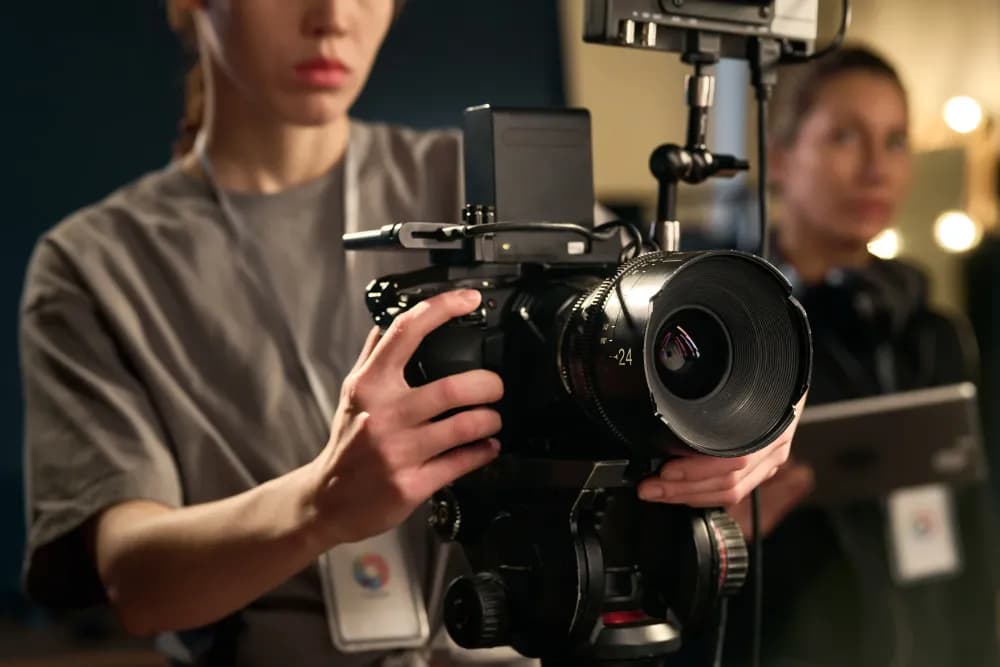The digitalised era of filmmaking refers to using digital tools to create, edit, and distribute video, replacing traditional film workflows. This shift brings benefits such as faster production, greater flexibility, lower costs, and easier distribution online. With secure video hosting platforms like Cinema8, filmmakers can go further by adding interactive and immersive storytelling. In this guide, we’ll explore the key benefits of digital filmmaking and how these tools are reshaping the industry.

What are the techniques used in digital filmmaking?
Digital filmmaking combines classic storytelling with modern tools that simplify every stage of production. Common techniques such as digital storyboarding, drone filming, and timeline-based video editing make it easier to plan, shoot, and adjust scenes quickly without the cost or constraints of traditional film.
In post-production, editors can collaborate remotely, sharing files across continents in real time. With the help of private video hosting platforms, filmmakers can store, review, and distribute content securely while tracking viewer engagement. This shift has made the entire filmmaking process faster, more flexible, and globally connected.
6 key benefits of embracing digital filmmaking
Today, it’s easier than ever for anyone to step into the world of filmmaking. From students working on class projects to aspiring creators experimenting with their first short films. Below are some of the biggest advantages of digital filmmaking.
1. Digital filmmaking reduces production costs
Digital filmmaking removes many of the expenses associated with traditional film. Film reels, development labs, and physical storage are replaced by memory cards, cloud backups, and digital file transfers. Even better, you don’t need to sacrifice quality for cost. Today’s digital cameras rival (and in many cases, outperform) traditional formats. And with reusable media, you can shoot more, try different takes, and experiment freely, without worrying about blowing the budget.
2. Faster timelines with digital workflows
Digital workflows dramatically reduce the time it takes to move from concept to final cut. You can review footage immediately after recording, tag takes with metadata, and begin assembling scenes on the same day. Non-linear editing tools let you create rough cuts faster and switch between versions without starting from scratch.
Cloud-based platforms enable automated syncing between devices and editing suites, so teams can access footage in real time. With fewer delays from processing, printing, or manual transfers, digital filmmaking helps you hit tight deadlines without sacrificing quality. And when paired with a video hosting solution, it's easy to send drafts, gather feedback, and keep everyone in the loop.
3. Creative flexibility on set
Capturing multiple angles of a scene, spontaneous moments, or behind-the-scenes footage is simple with digital filmmaking. You can run plenty of cameras at once, reshoot instantly, or capture rehearsals, all without worrying about film waste. Filmmakers also benefit from stabilisation gear, drones, and lightweight equipment that make storytelling more dynamic and visually interesting. You can even plan for interactive video elements during filming, allowing audiences to explore alternate endings, click through storylines, or respond in real time.
4. Smarter distribution with video hosting platforms
Gone are the days when filmmakers had to rely solely on festivals, cinemas, or physical distribution.
Now, video hosting platforms give you full control over how your film is seen. You can go public on YouTube, partner with community theatres, or even opt for private video hosting for client previews or restricted screenings. You can also password-protect content, gather viewer insights, and manage access in a way that suits your project. Additionally, some hosting platforms let you update files, add interactive layers, or include captions without re-exporting an entire film.
5. Easier collaboration and real-time feedback
Digital filmmaking streamlines collaboration across departments and time zones. You can share work-in-progress edits securely, collect timestamped feedback, and make revisions on the fly, all thanks to online video hosting and collaborative editing tools.
If you need feedback during filming, you can record, upload, and get notes back, all in the same day. For larger teams or remote productions, this level of agility helps avoid costly reworks and keeps everyone aligned.
6. Built for interactivity and next-gen experiences
Modern storytelling needs to meet audience expectations of immersive, engaging narratives and experiences. Digital filmmaking is what makes that possible. With interactive tools like those offered by Cinema8, you can transform your final cut into an interactive video that invites viewers to explore different paths, answer questions, or click through to more content. These features can increase engagement and give you richer insight into what your audience cares about. Pairing these interactive features with A/B testing tools offers additional benefits by showing which movie endings or scenes resonate best with your audience and helping you create interactive stories that truly connect.
Final thoughts on digital filmmaking
Digital filmmaking has transformed how stories are created, told, and distributed. By replacing rigid, time-consuming processes with flexible, scalable workflows, filmmakers now have the tools to move faster, collaborate globally, and tell richer, more immersive stories. From cost savings and cloud-based editing to interactive video experiences, the digital shift has made professional filmmaking more accessible and impactful than ever before.
If you’re ready to take your projects to the next level, Cinema8 brings a secure hosting solution, video editing and interactive tools, and powerful analytics together; so your stories can truly perform well. Start your free trial today and experience what modern video creation can really do.
